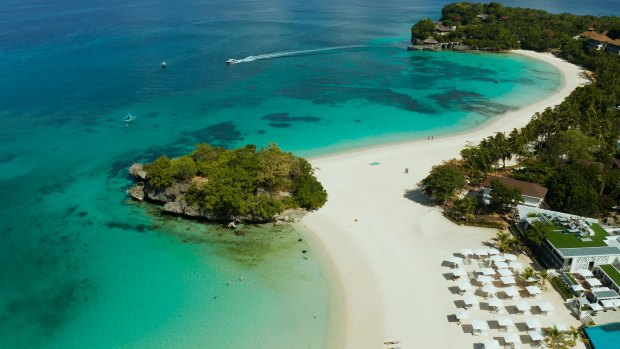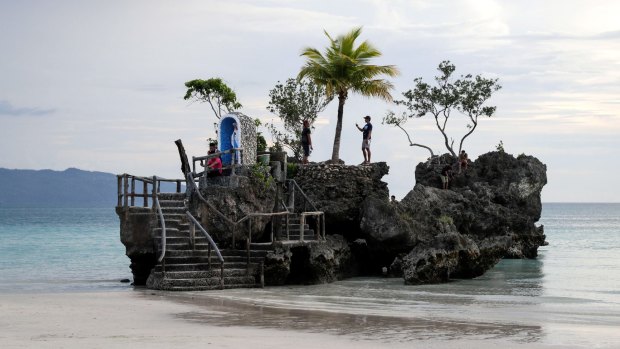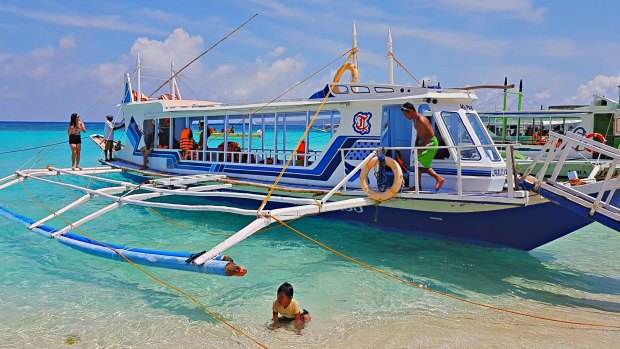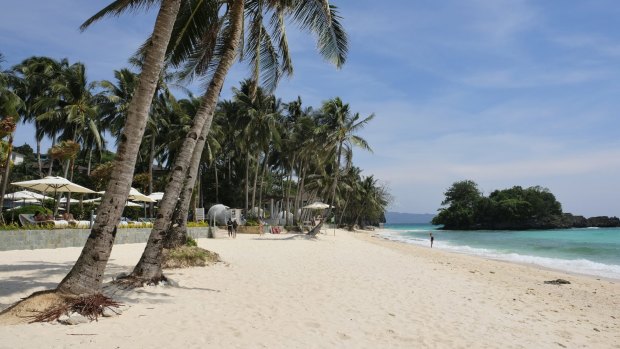This was published 4 years ago
Travel tips and advice, Philippines: Is the 'new' Boracay worth returning to?
By Steve Meacham

Boracay was named the world's most beautiful island in 2012.Credit: Getty Images
We're watching the sunset from the foredeck of a luxury yacht, sipping wine and nibbling canapés as we sail through the pristine blue waters of a tiny Filipino island which Travel+Leisure magazine declared "the best in the world" in 2012.
Can it get any better than this?
Steve Broderick – our host aboard Mahal ("Love" in Filipino) and Lilyan, his Chinese-born wife – moved to Boracay in 2010, escaping corporate life to launch this high-end tourist excursion.

People pose for pictures on the Boracay Grotto also known as 'Willy's Rock'.Credit: MARK R. CRISTINO
The Brodericks came to Boracay from stressful Shanghai and bought the catamaran they renamed Mahal to appeal to cashed-up clients wishing for an upmarket cruise.
For seven years it was plain sailing. Then, for six months in 2018, Boracay was hit by a perfect storm. Call it "Typhoon Rody".
Rodrigo Duterte ("Rody" to compliant Filipino media) is the 16th President since the Philippines gained independence from the US in 1946. He's also the most controversial since dictator Ferdinand Marcos was ousted in "the people's revolution" of 1986.

One of the bangkas - traditional Filipino fishing boats - bringing tourists to Puka Beach, Boracay.
Though Duterte is a human rights pariah, he has an 80 per cent domestic approval rating, something most Western politicians would die for.
Oddly, Duterte is also an environmentalist. On his orders, Boracay (then the most popular beachside escape in an archipelago of 7500 islands) was shut down for six months from April 2018.
It was a closure unprecedented in Filipino history, and possibly the world. Imagine Scott Morrison closing the Gold Coast for half a year, though our PM probably wouldn't use Duterte's blunt language: he described Boracay as "a cesspool".

The beach at Mövenpick Resort Boracay.
Duterte was right. Once an undiscovered haven for Aussie backpackers and their ilk, Boracay had become an insanely overdeveloped tourist trap (mainly catering to Filipino, South Korean and Chinese tastes).
Apart from the terrible sanitation (raw sewage flowing out to the bays where holidaymakers swam), the once idyllic beaches were overcrowded with hawkers, illegal bars, massage tents and all-night dance parties.
It's now a year since Boracay reopened to tourists in October 2018. And be warned: it is still a work in progress – despite Duterte's government placing a 19,215 limit of tourists at any one time, with a maximum of 6405 arrivals each day. (It's unclear how those arbitrary targets will be enforced).
Boracay is a great example of that old Chinese proverb: "Be careful what you wish for." In 2011 – the year after Travel+Leisure put Boracay on an international bucket list – only 10,442 Australians holidayed here. Four years later, that had doubled to 20,130 – still a tiny percentage of the 767,088 foreign tourists who visited in 2015 (also with 748,000 Filipino vacationers).
Then came Duterte's unexpected shut-down. Hotels, tour operators and locals were given two months to prepare for half a year without an income.
Boracay-born residents were paid a month's wages to clean up the beaches, repair the roads, dig new sewers. But the entire island did it tough. Hotels and businesses desperately tried to persuade staff to stay, but many left for other islands.
In the meantime any buildings within 30 metres of high tide were demolished (you'll still see some bulldozed straight through the middle). Every former "private" beach was made freely accessible to all (locals and tourists alike). And beer bottles and cigarettes were banned from every piece of sand.
So is Boracay now worth visiting, a year after its soft reopening?
An unqualified yes, if you know what you've signed up for – and especially if you're staying in the five-star enclave known as "Station Zero".
Boracay's most celebrated attribute is White Beach, which stretches for 4km along the western shore and is now lined with most of the hotels and hostels.
Traditionally White Beach is divided into three "stations" – 3, 2 and 1 – which run south to north and refer to actual spots where ferries from the "mainland" (the larger, neighbouring island of Caticlan: where the airport is) used to drop off locals closest to their homes. Nowadays, the higher the station number, the cheaper the accommodation is likely to be. Many younger visitors prefer to stay mid-island at Station 1 because that's where most of the daytime action and nightlife is.
At some point you'll find yourself in d'mall, an outdoor shopping bazaar which runs across the island's midriff from Balabag Lake to White Beach's sand-side bars and restaurants.
There are good hotels in Station 1, including the Lind and Discovery Shores. But most of Boracay's 5-star resort hotels are concentrated on the island's northern tip – the so-called Station Zero. Each luxury hotel has its own beach access, water sports and other activities – plus restaurants serving superb international and Filipino cuisine.
Don't know what Filipino cuisine is? True, it isn't universally appreciated, unlike Thai, Malaysian, Vietnamese, Indian, Chinese or Indonesian. But since 1542, the Philippine archipelago (the only predominantly Catholic country in SE Asia) has been invaded by the Spanish, Americans and Japanese, so expect all those influences adjusted for a sweet tooth.
Locals queue for Jollibee, the Filipino version of Maccas or KFC (it has made its founder into a multi-billionaire). But the re-cleansed Boracay is blessed with great restaurants serving superb seafood, shellfish, vegetables, pork, poultry and (often, prime Australian) beef.
Puka Beach, apparently, was one of the triggers that led to Duterte's shutdown. Piled with rubbish and rife with petty thieving, it had become a disgrace. Puka had been brought to international attention by film star Elizabeth Taylor, who visited in the Sixties after she had been presented with a necklace made of puka shells from this beach by Imelda Marcos.
Taylor helped turn Boracay into a Hollywood hideaway – though only one half-decent movie has ever been filmed on the island: Too Late The Hero (1970: starring Michael Caine and Henry Fonda). You won't find puka shells on Puka Beach anymore, but you will be able to swim in gorgeous aquamarine, unpolluted waters.
The cost of the Boracay shutdown was at least $US1 billion. Andre Brulhart, of the 300-room Movenpick resort, confesses the shutdown came at the worst possible time: the resort had just completed a huge renovation.
Publicly, at least, Brulhart now says Duterte's instincts were right. So does Broderick on board Mahal. Visitor numbers are back where they were before the ban, he says.
Should you need further evidence of born-again Boracay, two activities from Bulabog Beach, on the windier eastern side of the island which is the hub for many ocean adventures, might persuade you.
The Philippine archipelago is known for its great scuba diving (and Boracay is no exception). But anyone over 10 and under 60 can sample Nemo's world by signing up for "Helmet diving".
Essentially, it means having a 32kg diving helmet placed over your head at the bottom of a boat ladder, before sinking (with the air hose fully connected) to the "Octopus' Garden" five metres below.
And yes, you do see clownfish in between posing for photos. But for the finest view of the new Boracay, sign up for a parasail behind one of the main speedboat operators at Bulabog.
From 100 metres above the Sibuyan Sea, there's only two things missing. Can someone pass the wine and canapés?
THE NUMBERS
On the last available figures, the five most popular Filipino Islands are Bohol (641,000 non-Filipino visitors), Aklan (572,000), Borocay (565,000), Camarines (514,000) and Puerto Princess City (481,000). The five leading nationalities of tourists visiting the Philippines are South Korea, China, US, Japan and Australia.
TRIP NOTES
FLY
Philippines Airlines flies to Manila daily from Sydney, five times a week from Melbourne (daily from November) and five times a week from Brisbane – with connections to Boracay. See philippineairlines.com
STAY
Movenpick Resort and Spa, Boracay, room and breakfast from $235 a night, see movenpick.com
EXPERIENCE
For a sunset cruise, see boracay-sailing.com. For helmet diving and parasailing, see boracayadventures.com
MORE
Steve Meacham was a guest of Philippine Airlines and Philippine Department of Tourism.
Sign up for the Traveller Deals newsletter
Get exclusive travel deals delivered straight to your inbox. Sign up now.